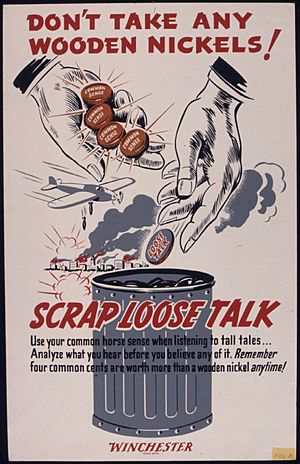Wooden nickel facts for kids
A wooden nickel is a special wooden coin or token. In the United States, businesses or banks sometimes give them out as a way to promote something. You might even be able to trade one for a specific item, like a drink!
Contents
What Are Wooden Nickels?
Wooden nickels are a type of token coin. They are not real money issued by the government. Instead, they are made of wood and often have a value printed on them, like "five cents" (a nickel). They are usually used for special events, promotions, or as souvenirs.
A Brief History of Wooden Nickels
People have used special tokens and scrip (which is like temporary paper money) for a long time. This often happened during tough economic times, like financial crises or wars. These tokens helped local communities keep money flowing when regular coins were scarce.
Wooden Nickels During the Great Depression
During the Great Depression in the 1930s, many banks failed. One example is the Citizens Bank of Tenino in Tenino, Washington. To help people, the local Chamber of Commerce and a newspaper worked together. They printed special paper scrip that was worth 25% of what people had in their bank accounts. People could spend this scrip at local stores.
- Soon after, Blaine, Washington, did something similar. They made both paper scrip and wooden coins, including a 5-cent piece.
- In 1933, the Chicago World's Fair even gave out wooden nickels as souvenirs. This helped make them popular.
Wooden Nickels Today
The idea of using wooden nickels as tokens and souvenirs is still around today. They are often given out at fairs, festivals, or special events.
How Tenino Used Wooden Nickels Again
In a modern twist, Tenino, Washington, used wooden scrip again during the COVID-19 pandemic. They started a program called the COVID-19 Grant Recovery programme. If someone got a grant, they received wooden scrip. This scrip could be spent at participating shops in the town. People could also use it to help pay their city utility bills. This helped both the citizens and local businesses.
"Don't Take Any Wooden Nickels"
You might hear the saying, "Don't take any wooden nickels." This is a friendly reminder to be careful and smart in your dealings. It means you should be cautious and make sure you are getting something real or valuable. This saying was around even before wooden nickels became common as temporary money. It likely came from the idea that a wooden nickel was not real money, but just a novelty or souvenir.


